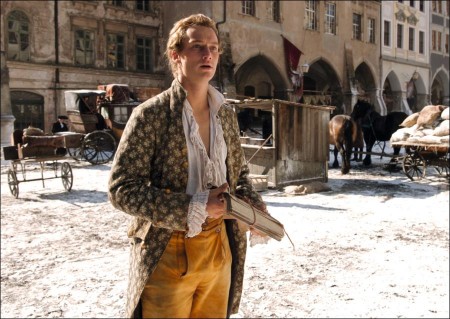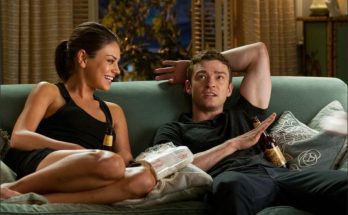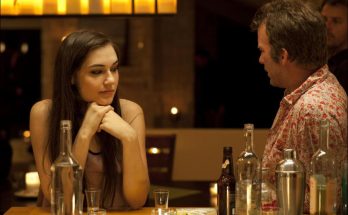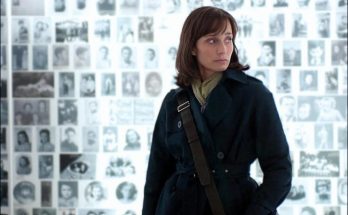Germany 1772 – the young Johann Wolfgang von Goethe aspires to be a poet; but after failing his law exams, he is sent by his father to a sleepy provincial court to mend his ways. Unsure of his talent and eager to prove himself, Goethe soon wins the praise of his superior Kestner. But then Lotte enters his life and nothing is ever the same. However, the young lovers are unaware that her father has already promised Lotte’s hand to another man.
Director and co-writer Phillip Stölzl returns to the very wellspring of Romanticism, Goethe’s loosely autobiographical masterpiece The Sorrows of Young Werther, and conjures up a beguiling and refreshingly innocent period romance.
Producer’s Note
Goethe is Germany’s most famous and important poet and philosopher, yet there has never been a relevant feature film about this extraordinary personality. There’s a reason for this, too: Goethe could do everything and was everything! He was handsome, came from a wealthy family, wrote successful novels, theater plays and poems, was an accomplished horseback rider and fencer, invented roller skates and discovered the pharyngeal bone, and he was a natural scientist, privy councilor, traveler, artist, minister, lawyer, and much, much more – all in all, a universal genius and thus a completely non-dramatic character for a feature film! But there was a time in young Goethe’s life when he was tortured by self-doubt and self-discovery. A time when he almost died due to an unrequited love, and the only thing that rescued him was dealing with the episode by writing about it.
The film Young Goethe in Love tells the story of this 23-year-old, who achieved his greatest artistic success as a result of his greatest love pangs: The Sorrows of Young Werther. The appeal of the story is that it shows Goethe was not always the mythical figure and all-round genius as portrayed in thousands of books, interpretations and theories, but rather a young man who loved and suffered. – Christoph Müller
About the Production
“What’s exciting about the story of how Werther was created is that it was Goethe’s most personal, almost autobiographic novel, a work he was the proudest of, along with ‘Faust’,” says producer and co-writer, Christoph Müller.
“What’s also unusual about the publishing history of Werther is that the exciting story in the epistolary novel has always been, even back then, viewed in connection with the actual events in Goethe’s life. Almost every reader knew Goethe had experienced the love story with Lotte himself,” continues Müller. “The wave of suicides as a result of Werther was the first media phenomenon and had never been seen before. The young men who killed themselves after reading Werther, however, ignored, the fact that Goethe was able to rescue himself from his selfdestructive mood by writing the book.”
But not only unhappy lovers devoured the famous novel. “Werther was an immense catalyst of sentimental pessimism, yearning, and passion,” says Müller. “At first I developed a cinematic story that dealt with the period after the success of Werther and Goethe’s writer’s block afterwards – until my brother Markus came up with the idea that it would be much more exciting to develop the story of the ‘blissful and dangerous summer of 1772 in Wetzlar,’ which led to the creation of Werther. We then worked on different constellations of this story for a long time, but it wasn’t until Philipp Stölzl and our young co-author, Alexander Dydyna, came along that we finally managed to hit on the right concept for the script.”
Director and co-writer Philipp Stölzl adds, “I thought the idea to tell the story about the young Goethe was great – about Sturm und Drang, about the period when he still wasn’t the famous privy councilor, minister, and poet laureate. Goethe studies law, he writes poetry, he falls unhappily in love, he fights with his father. This has elements of a young man’s rebellion; this is a Goethe you want to see in the cinema.”
Müller says about the celebrated director of NORTH FACE: “I thought working with Philipp was very inspiring; I like how precisely he handles language, timing, and direction. For me as the producer, working together on the screenplay is the ideal way to do it, because you can adjust extremely well to the director’s work methods before you start shooting the film.”
Stölzl adds, “At the same time, financing the film worked out very well and happened very quickly. We only needed about a year, from the moment we started to write the script to the moment we began shooting the film. Goethe as the concept, Christoph as the producer, me as the director that worked.”
Müller continues, “A historical film is just as elaborate as a science fiction film; you have to create a completely new world, because you can’t find locations that look the way things looked in the 18th century anymore.”
New and familiar faces in front of the camera
“Alexander Fehling had already been in films, but I didn’t know him,” says Stölzl. “He was the first candidate to show up at casting for the role of Goethe, and I knew after a minute that he’s our lead. He was 100% convincing. And then shooting with Alexander confirmed it completely.
He’s an absolutely exceptional actor. He can play the comical moments as well as the tragic ones; he has an unbelievable palette – everything you want from an actor. We were extremely lucky to find him. His precise performance is also the result of our close collaboration, as we worked on and tried many variations together to arrive at what would serve the role the best.”
On casting Miriam Stein as Lotte, Müller explains, “It’s very, very rare that you discover someone like Miriam. With Goethe and also with Lotte, we considered whether we should cast established stars, because with an elaborate costume film, in your mind you automatically see big names on the film poster. But we liked Miriam best for the role of Lotte. Though she he had never been in a feature film before, she rewarded us with her unbelievably intense performance.” Stölzl agrees, “As Lotte, with her tousled hair, young Miriam Stein is the right contrast to Goethe. Most of all, she’s a convincing actress with a large emotional range, which enraptured me and made me proud.”
Goethe is not the only one who falls in love with Lotte – his superior, court councilor Kestner, does, too. Moritz Bleibtreu plays this role. “Moritz feels at home in every genre, from drama to comedy,” says Müller. “With his very perceptive performance in the difficult role of Kestner he resonates with the audience.” Stölzl adds, “You could have also cast Kestner as grayer and more bureaucratic. But we also wanted to show him as an attractive man; the audience has to believe he wants to marry this girl at any cost. There’s something touching about that. This means the two men trying to win over Lotte’s heart have more or less the same chance. If you wanted to make the accents clear from the start, then over here you would have the young, good-looking wild one, and over there the plain, boring one, who can only offer the girl a long and dismal married life—but then there wouldn’t be any tension. That’s why I’m even happier now about how well the triangle works between the men and Lotte.”
The ensemble includes two renowned actors as the fathers: Burghart Klaussner and Henry Hübchen shine with the qualities you want to have in these small yet decisive roles.
Goethe’s World – Smoke and Patina
“As the audience, you know and fear the costume film, where the actors seem to be wearing costumes and you have the feeling any second now in the background a group of tourists is going to walk through the castle,” says Stölzl. “That’s usually because the filmmakers want to present history as being cleaner than it really was. So as our guideline, we used the fact that when Goethe was alive the toilet hadn’t been invented yet. If you look at the historical paintings of German cities you realize that at that time they didn’t have paved streets yet, just mud, and the buildings were crooked and warped, paint peeled off the facades, chickens ran around everywhere, sewage flowed through ditches in the middle of the street. At night it was pitch dark, as they only had candles for light.”
“So we wanted to have realistic images: smoke and patina are perhaps the best words to describe it,” adds Müller. “The streets back then were muddy and dirty, you sense that traveling was exhausting and you had to overcome hindrances; there were vapors, smoke, and noise. Appropriately, not one of our costumes looks like it was delivered by a costume warehouse that morning. All of the clothes in our film were artificially patinated so they look as if the characters in the film had already been wearing them for a long time. The audience shouldn’t be amazed by museum-like images, but rather notice that they’re watching a modern, entertaining and yet historical film. This impression is really important to us – that’s why we make sure that the sets and costumes are accurate.”
Stölzl continues, “The costumes of the period present a big problem for filmmakers. Many of the people at that time still wore wigs, and other people had already cut off their proverbial ‘old pigtails’ and wore their own hair short. When you see men in wigs and those knickerbockers they wore at that time they often look a little absurd, so we had big problems creating the costumes in such a way that they looked wholeheartedly convincing. But in the end we succeeded.”
For the production design Stölzl notes, “I insist that everything look as authentic as possible. We researched the 18th century with the wonderful production designer Udo Kramer, who had already worked with me on NORTH FACE, and we used paintings by Canaletto as a starting point. What did the cities and buildings look like at that time? What kinds of different architecture existed? What did the interiors look like? We found most of the locations that suited our purposes in Eastern Germany, in Thuringia and Saxony. From a practical point of view, we also wanted to find as many locations as possible that were very close together.
We always planned to use original locations, and we would then add elements to suit our purposes in individual cases. The film crew put everything that was missing into the existing spaces to round out the overall image. This ‘mixture technique’ was invented by Udo and it’s what prefer, because one hundred percent of studio sets always lack the last speck of authenticity, and if you use an original location then you often have the feeling you’re in a museum because the filmmakers aren’t allowed to change anything or adapt it for the camera. The mixture technique demands a lot of supplemental work from the set designer, but the result is more homogenous.”
The main locations in the film are the courthouse in Wetzlar and the Buff family home. For the Buff home, the filmmakers selected Wasserschloss Tauchritz, a rather dilapidated castle with a moat, near Görlitz on the Polish border. The location was noticeably altered: stairs, a kitchen, and a fireplace were added. The patina was left on the walls, but a lot of paint was necessary to make it suitable as a film location. In general, sixty percent of the set was the original space, and forty percent was added by Kramer and his set design crew.
For the courthouse, the film team chose a Renaissance building in Görlitz that is normally empty. Inside the building, the set crew used many of the actual walls and floors and added some interior decoration to attain the right composition. The scene of the poetry reading in the Rococo atmosphere was shot in Görlitz at the local museum. It was important to plan everything with the director of photography Kolja Brandt, because he couldn’t move the walls for the best camera position like you can on a studio set.
“From the start, we selected the locations in such a manner that the camera could be moved freely. The jail cell was the exception, because it was too narrow,” remembers Stölzl. “On the other hand, I don’t really like to use the movable walls in a studio, because if you use them too much and the camera is positioned too far from the objects you get an artificial look like a ‘studio.’ Overall, you find yourself on thin ice very quickly with a costume film, because often the characters seem very artificial in their powdered wigs. I did research for a long time and watched a lot of films to make sure I avoided this. The questions concerning lighting are part of this, too. They only had candlelight at that time – and that’s often too dark for the camera. How much light should you add? You have to find a middle ground to show how the world looked back then in a way that’s as believable as possible. That’s why we decided to shoot only in real buildings.”
Fact and Fancy
“The film YOUNG GOETHE IN LOVE is based for the most part on actual events. But if a Goethe expert were to say that this or that scene never happened, that’s the wrong way to approach our film. We were more concerned about showing truths, which are more important than pure facts. You can’t get very close to historical characters with facts alone,” says Müller. “It was like that with AMADEUS and SHAKESPEARE IN LOVE.”
Müller mentions an example: “In reality, the duel between Goethe and Kestner in the film never took place. But it’s been proven that Goethe wished Kestner would die. Of course, you can convey that with dialogue. But it’s more cinematic to transcribe this motif into dramatic images, to express what was really affecting Goethe in this situation. The duel sequence expresses, so to speak, Goethe’s true emotions. An extreme example of such a dramatic truth is the key scene in Schiller’s play ‘Maria Stuart,’ when Queen Elisabeth I and Maria Stuart have an argument in a park, although these historical figures never met. Schiller’s theatrical invention gets us closer to these two people than all of the facts rolled together ever could.”
“In our film, we combine Goethe’s actual life with his own reflections on his life in Werther, and this results in a new truth,” says Müller. “We even express this theme in the film, when Lotte is asked, ‘Did it actually happen this way? Is all of this true?’ And she answers, ‘It is more than the truth. It is poetry.’”
Young Goethe in Love
Directed by: Philipp Stölzl
Starring: Alexander Fehling, Miriam Stein, Moritz Bleibtreu, Volker Bruch, Burghart Klaußner
Screenplay by: Christoph Müller, Philipp Stölzl
Production Design by: Udo Kramer
Cinematography by: Kolja Brandt
Film Editing by: Sven Budelmann
Makeup Department: Judith Anthony, Anja Hartung, Marika Knappe, Kitty Kratschke, Monika Lienig, Christin Läßig, Heike Merker, Jeanette Selcuk
Music by: Ingo Frenzel
MPAA Rating: None.
Studio: Music Box Films
Release Date: November 4, 2011
Hits: 169






